Patagonia

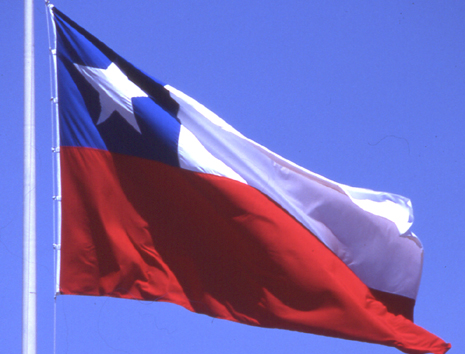
Patagonia is the name used for the southern areas of Chile and Argentina. The definition is a bit loose, but the name is often applied to anywhere south of about latitude 40º. In Patagonia the weather becomes increasingly poor as you travel south. In the northern area the climate is almost Mediterranean, but in the far south the climate is like that in Scotland. On the Chilean side of the mountains there are some incredibly wet places where rain falls on over 350 days of the year. On the Argentine side of the mountains there are much drier steppes where it rarely rains but is always very windy. The area is very popular for walking, but this usually involves at least some backpacking as opposed to trekking with donkeys/mules. Other activities such as rafting and mountain biking are increasingly popular.
The Lakes District
The northern section of the Patagonian Andes is better known as the Andean Lakes District. It is a stunningly beautiful region of blue lochs, thick forests and snow capped volcanoes which straddles the Chile-Argentina border. This is without a doubt the most underrated area of the Andes, with good weather, absolutely superb scenery and hundreds of tea rooms serving excellent cakes. The area also has a lot of short hikes and backpacking trips in wild and untouched forests, some superb areas for mountain biking, and a selection of easy volcanoes to climb including the spectacularly active Volcan Villarrica. This is the best place in the Andes to come if you want a hotel based holiday doing some easy day walks or other activities in superb scenery.
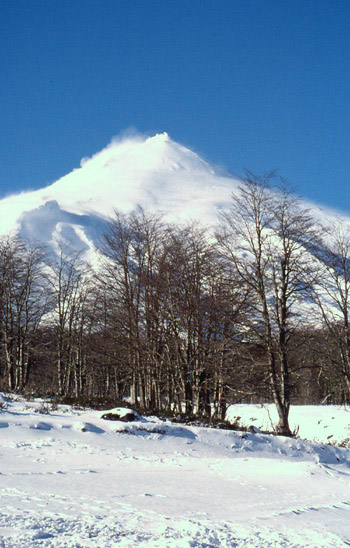
Volcan Villarrica in winter
In the Chilean Lakes District any multi-day hike will need to be done as a backpacking trip. The majority are forest based walks, often through stands of the unusual monkey puzzle trees. In the north of the region the circuit of Volcan Antuco takes three days and you can add another day to climb the peak. This hike is mainly through lava deserts and volcanic wilderness and crosses a pass of over 2000m. In the Villarrica National Park the "Villarrica Traverse" and "Villarrica circuit" both offer varied trekking through monkey puzzle forest, grassland and volcanic plateaux with great views of several snow capped peaks. Both trips will take 4-5 days and they can be combined to give a longer tour. Further south on the Chilean side of the mountains is the Puyehue traverse, again offering a mixture of forest and lava flow backpacking. All these areas have good one day walks as well.
On the Argentine side of the Andes the rugged Cerro Catedral group of peaks offer good mountain walking. They are located in the Nahuel Huapi national park only one hour from the town of Bariloche. This is one of the few areas of the Andes where you can do a hut to hut tour as you would in the Alps. The peaks are just over 2000m high and the passes are up to 1800m high. The longest circuit takes you from Lago Gutierrez past the Refugios Frey, Jakob, Segre to the Refugio Lopez. There is some scrambling on this route. Many other hut based walks are possible in this very accessible and therefore relatively popular area of the Andes. This area also has some very good rock-climbing.
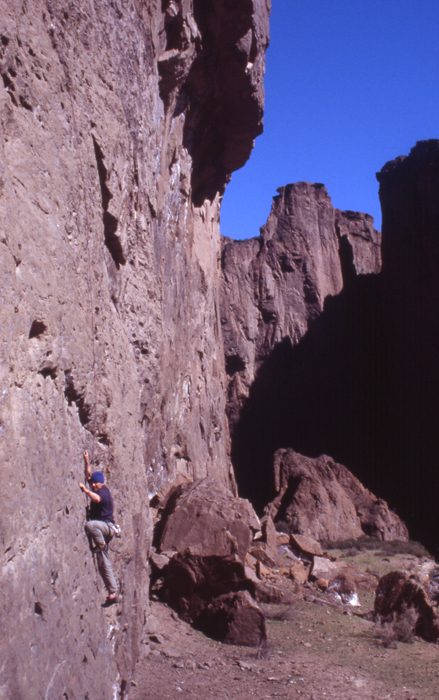
Sport climbing at Piedra Parada, east of Esquel, Chubut province.
One of the highlights of any trip to this area of South America should be an ascent of the active Volcan Villarrica. An ascent in 2003 was the most exhilarating thing I have done in my life. The level of activity varies from year to year but is never disappointing. In recent years there has been a pool of molten lava in the bottom of the crater, frothing and bubbling and occasionally spurting up the sides of the crater before slopping back down. This is probably not very safe but it is totally overpowering to witness. This is the earth boiling and you can smell, feel, taste, see and hear it. Don't miss it. Day trips up the volcano are available in Pucon for about $100 including lunch and all equipment necessary including an ice-axe and crampons. Because of recent accidents (in crevasses, not in hot lava pools) the authorities do not always allow unguided ascents, but if you can prove you are an experienced climber and are not climbing alone you should be OK. Other volcanoes in the area give very interesting if not quite so spectacular ascents. Llaima, Lonquimay and Osorno are all one day ascents.
The Lake District and in particular Pucon has become something of a centre for rafting in recent years. there are many good rivers offering exhilarating day trips such as the Fuy and Trancura, both grade 3. If you want a longer river trip try the Bio-Bio (if its still open) or the Rio Futaleufu, both giving 4-5 day excursions through rapids up to grade 5.
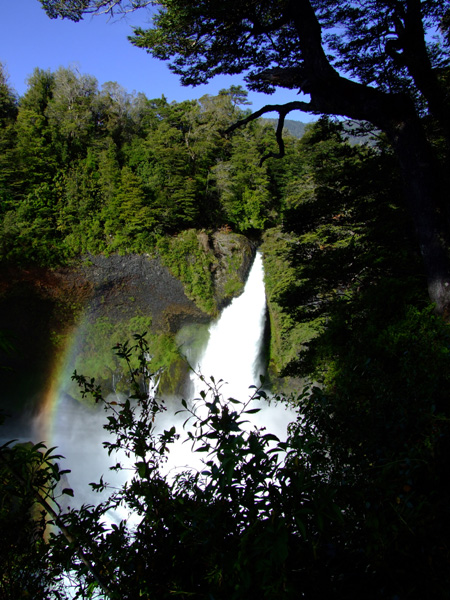
Waterfall on the Rio Fuy
The Chilean Lakes District is particularly suitable to mountain biking especially if you like your home comforts. It is possible to tour here on a mountain bike using old forest roads and little used tracks to get from town to town, staying every night in comfortable but simple hotel accommodation. With plenty of tea-rooms stocked with cream cakes to stop at during the day the experience is complete. Of course you may end up not doing very much biking! Particularly recommended tours are around Lago Caburga and the pass between Villarrica and Quetrupillan in the Chilean Lakes and the Ruta de Los Siete Lagos near Bariloche in Argentina. If you like downhill biking there are also plenty of tracks such as those leading to the ski resorts on the volcanoes which can provide the necessary gradient.
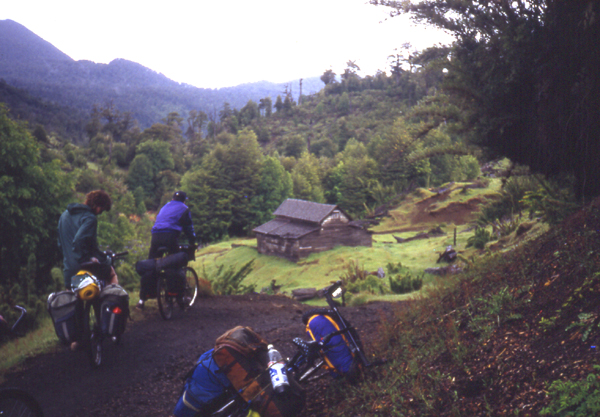
Multi-day mountain biking expedition in the Lakes District of Chile
Skiing is another growing sport in this part of the Andes with the best resorts on the Argentine side of the mountains at Cerro Catedral and Cerro Chapelco. Both resorts are near Bariloche, the only town that has become a real ski town in the whole of South America. On the Chilean side most of the volcanoes have small resorts on them with up to 900m of vertical runs. Villarrica, Choshuenco, Antillanca, Antuco and Chillan are all regularly skied on. In the June-September season skis can be hired in the nearby towns.
All the volcanoes mentioned above also make very good ski-touring ascents, but if this is what you're planning to do you will need to bring your own equipment from home.
The best access cities for the Lakes District are the city of Temuco in Chile or the town of Bariloche in Argentina. Both can be reached by air or bus from the national capitals. However the Lake District has many large towns that will make equally good bases for adventurous excursions.
Los Glaciares National Park
The world famous Los Glaciares national park in southern Argentine Patagonia is 1500km south of the Lake District. It includes the famous granite peaks of Fitzroy 3405m and Cerro Torre and some huge glaciers on the edge of the southernmost of the two Patagonian ice caps. With their subsidiary peaks these mountains are the most impressive rock peaks in the Andes and very difficult ascents even for experienced mountaineers. Imagine 1000m of difficult vertical rock climbing in weather as unreliable as that in Scotland!

Fitzroy and Aguja Poincenot from the east at sunrise
There is good backpacking country in the rich evergreen beech forests at the foot of these spectacular mountains, with beautiful and secluded campsites, particularly in the remote northern part of the park around Laguna del Desierto. One highlight of this park are the views of the mountains from the glacier lagoons; particularly recommended are walks to Laguna Sucia, Laguna de los Tres and Laguna Torre. It is also possible to see many of the most scenic areas of the park, including these three lagoons, in day hikes from the wee town of Chaltén. Access to the park is usually initially from the airport at the town of Calafate. This touristy town lies on Lago Argentino. There are regular buses from here to the park entrance in Chalten in summer. Calafate is also a good centre for rafting and wildlife excursions and a good place to buy your supplies.
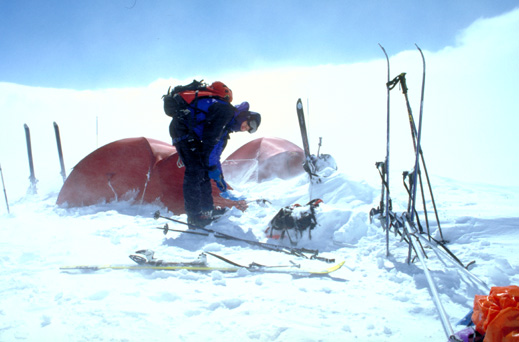
Digging out a tent after a storm on the south Patagonian icecap
Torres del Paine National Park
Even further south and reached from the town of Puerto Natales in Chile, is the famous Torres del Paine national park, named for several steep rock towers (torres is Spanish for towers) rising to around 2500m. There are three Torres, conveniently known as the south, central and north. Nearby are the equally steep Cuernos del Paine and the highest peak in the range, Paine Grande c.2750m which is a massive bulk of a mountain guarded by big hanging glaciers.
Like Los Glaciares, the Paine are a superb area for backpackers who can enjoy hiking through evergreen beech forests at the foot of such magnificent peaks. Many short walks can be done in the Torres del Paine park, but most travellers like to do the famous circuit trek around the Paine massif. The hiking is mostly through open forests or grasslands but there is also a pass of about 1350m sometimes with snow cover. Horses can't cross this pass so you will need to carry your own backpack at least some of the way if you want to do the complete circuit. The walk can be done in either direction equally easily, though in bad weather it will be much easier to navigate over the pass if walking clockwise. Maps and up to date information about the route are easily obtained in Puerto Natales or at the national park headquarters. Sadly, but perhaps inevitably this great wilderness walk is now quite heavily used and the park authorities are having to build toilets, refuges and organised campgrounds on the circuit. The fees have got quite expensive now and you now need to have all overnight stays pre-reserved. Another notable long distance walk is the two day circuit to Pingo and Tyndall from Lago Grey
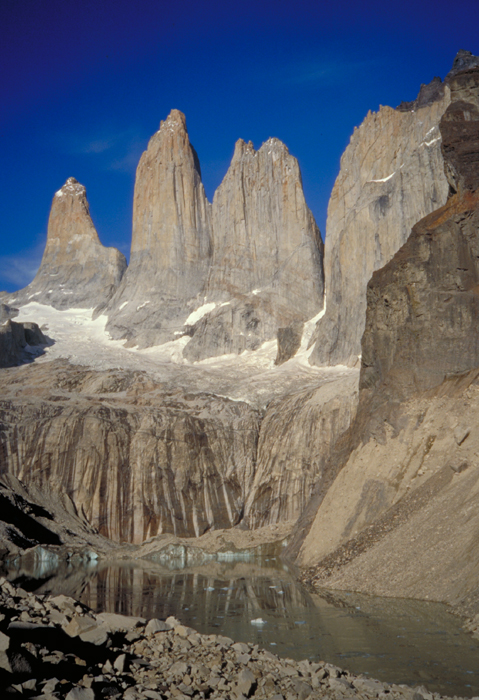
The Torres del Paine from the classic viewpoint.
If you don't fancy carrying your backpack for several days there are plenty of good day walks available in the park. The best of these has to be the walk up to the small lochan at the foot of the Torres del Paine. This popular hike takes 4-5 hours return from the campsite Los Torres at the eastern end of the circuit. It is steeply uphill but the views are worth it. Further up the main valley of the Rio Ascencio is a desolate wilderness of boulders and big rock walls that makes a very good but long days walk.
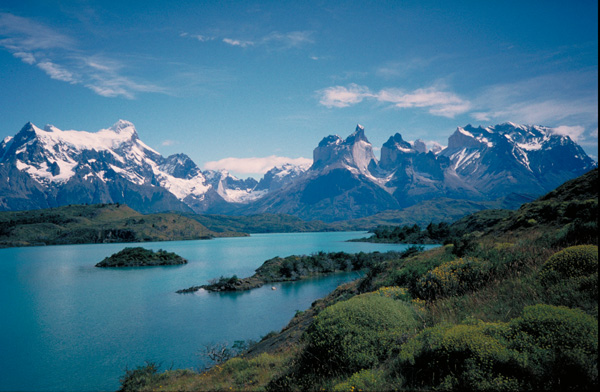
The Cuernos del Paine from Lago Pehoe.
Patagonian Wildlife
Patagonia has some great places to go and see wildlife. The two parks mentioned above and indeed the walks within them offer great chances to see many common species such as condors, guanacos, parrots, flamingos, rheas. Indeed the Torres del Paine national park is probably the best place in the Andes to go to see nearly all of these species and is certainly the place you are most likely to see a condor. Also nearby are several penguin and sealion colonies that are worth a visit if you are in the area. Some are only accessible by taking a boat tour on the fiords.

Magellanic Penguin
One thousand kilometres further north on the Atlantic coast of Argentina is the Valdes Peninsula, one of the best wildlife national parks in South America. The land is mostly desert, with guanacos, rheas, flamingos, maras and armadillos easily seen, but it's in the ocean and on the beaches that this park really comes alive. You'll see elephant seals, dolphins, killer whales, right whales and huge numbers of penguins. This is where that famous wildlife film of killer whales rolling onto beaches to catch sealions was taken. For the best wildlife viewing come in the Patagonian spring (September to November). Access is via the city of Trelew, centre of the Welsh influence in Patagonia, with daily flights from Buenos Aires and Rio Gallegos. Boat trips to see the whales can be easily arranged in Trelew
Lakes District and Patagonia Factfile
When to go - The seasons in the Lake District and Patagonia are reversed from the northern hemisphere, with December to March being summer.
Weather - About the same as a summer in southern France in the Lakes District, hot at times, but also sometimes wet. About the same as summer in Scotland or England in Patagonia but with much more wind. Patagonia is actually windier in summer than in winter.
Flights - For the Lakes District fly from London to Bariloche via Buenos Aires or to Santiago then by air to Temuco or by bus to towns further north in Chile. Flights will cost from £1000. For southern Patagonia flights from London to Rio Gallegos or Calafate via Buenos Aires or fly to Punta Arenas in Chile via Santiago. Flights will cost from £1200-£1400
Guidebooks - There are trekking guides available published by Bradt and Lonely Planet. At ANDES we publish The Andes - A Guide for Climbers and Skiers by John Biggar which has details of all the volcano ascents in the area, plus information on many ski touring and ski-mountaineering opportunities.

